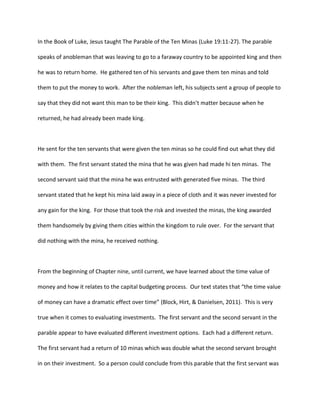Biblical view of Capital
•Download as DOCX, PDF•
0 likes•336 views
The Parable of the Ten Minas from the Book of Luke describes a nobleman who gave ten servants minas and told them to invest the money while he was away. When he returned, the first servant had earned ten minas, the second earned five minas, but the third servant did nothing with the mina. The nobleman rewarded the first two servants but punished the third. This parable demonstrates the concept of investment and time value of money, as the first servant took more risks and earned a higher return compared to the second servant. It also shows the importance of investing rather than doing nothing out of fear like the third servant.
Report
Share
Report
Share

Recommended
More Related Content
Featured
Featured (20)
Product Design Trends in 2024 | Teenage Engineerings

Product Design Trends in 2024 | Teenage Engineerings
How Race, Age and Gender Shape Attitudes Towards Mental Health

How Race, Age and Gender Shape Attitudes Towards Mental Health
AI Trends in Creative Operations 2024 by Artwork Flow.pdf

AI Trends in Creative Operations 2024 by Artwork Flow.pdf
Content Methodology: A Best Practices Report (Webinar)

Content Methodology: A Best Practices Report (Webinar)
How to Prepare For a Successful Job Search for 2024

How to Prepare For a Successful Job Search for 2024
Social Media Marketing Trends 2024 // The Global Indie Insights

Social Media Marketing Trends 2024 // The Global Indie Insights
Trends In Paid Search: Navigating The Digital Landscape In 2024

Trends In Paid Search: Navigating The Digital Landscape In 2024
5 Public speaking tips from TED - Visualized summary

5 Public speaking tips from TED - Visualized summary
Google's Just Not That Into You: Understanding Core Updates & Search Intent

Google's Just Not That Into You: Understanding Core Updates & Search Intent
The six step guide to practical project management

The six step guide to practical project management
Beginners Guide to TikTok for Search - Rachel Pearson - We are Tilt __ Bright...

Beginners Guide to TikTok for Search - Rachel Pearson - We are Tilt __ Bright...
Biblical view of Capital
- 1. In the Book of Luke, Jesus taught The Parable of the Ten Minas (Luke 19:11-27). The parable speaks of anobleman that was leaving to go to a faraway country to be appointed king and then he was to return home. He gathered ten of his servants and gave them ten minas and told them to put the money to work. After the nobleman left, his subjects sent a group of people to say that they did not want this man to be their king. This didn’t matter because when he returned, he had already been made king. He sent for the ten servants that were given the ten minas so he could find out what they did with them. The first servant stated the mina that he was given had made hi ten minas. The second servant said that the mina he was entrusted with generated five minas. The third servant stated that he kept his mina laid away in a piece of cloth and it was never invested for any gain for the king. For those that took the risk and invested the minas, the king awarded them handsomely by giving them cities within the kingdom to rule over. For the servant that did nothing with the mina, he received nothing. From the beginning of Chapter nine, until current, we have learned about the time value of money and how it relates to the capital budgeting process. Our text states that “the time value of money can have a dramatic effect over time” (Block, Hirt, & Danielsen, 2011). This is very true when it comes to evaluating investments. The first servant and the second servant in the parable appear to have evaluated different investment options. Each had a different return. The first servant had a return of 10 minas which was double what the second servant brought in on their investment. So a person could conclude from this parable that the first servant was
- 2. not afraid to take a risk and invest the mina in a high-risk opportunity. The second servant doesn’t appear to be too risk-averse either because he turned a profit as well for the king. The third however was very risk-averse and decided that it was better to keep the mina hidden away than to take a risk and invest. Not only was he risk-averse to invest the mina, he was also very afraid of the king which also added to his fear which eventually ended with his decision to not invest. Even in biblical days, we can see evidence of the concept of investment as well as the concept of gaining interest on the investment. A part of the Capital Budgeting Process is evaluating investment opportunities by looking at the time value of money as well as the risk involved to make a decision on how to invest wisely. References Block, S. B., Hirt, G. A., & Danielsen, B. R. (2011). Foundations of Financial Management. New York: McGraw-Hill/Irwin.